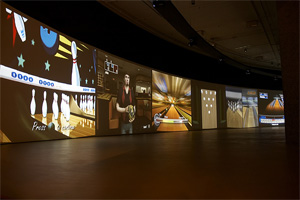Teen Idols
John Haberin New York City
Ryan Trecartin, Laurel Nakadate, and Cory Arcangel
I had sat on a sofa, a plastic swiveling chair, airplane rows, lawn furniture, and metal bleachers. I had sat at a conference or backyard table, lazed in a hammock, climbed up onto a bed on stilts like a crib or a theater loge, and toyed with gym equipment. I passed on the six-foot stepladders, either because the guards might stop me or because they might not. I had wandered amid some four hours of digital video, but not on monitors. I had entered mash-ups of Ikea and a wide-screen multiplex, with the sound on soft, old-fashioned headsets. They extend the sets, but other sounds entirely play over speakers. 
I had seen a pool party, a joy ride, a satanic ritual or an act of arson, any number of unexplained crises, and almost perpetual dancing. I had listened to confessions of love and pleas for love, pop songs and hissy fits, blank responses almost like therapy, and a lecture on cutting up the Constitution. I had heard from people across genders and races—quite apart from Ryan Trecartin in wigs, makeup, skin toner, and hair dye taking on them all. They make up a garage band, a girl group, and either triplets or quadruplets, because one may have merged with the other. They invade a home near Disney World, a fancy hotel, an anonymous grid of freeways at night, and the larger space of Vimeo, where the artist makes things available for free. If any of them is over thirty, they could fool me.
Trecartin lives so completely in the present that he can hardly know that I was ever there, much less that I am gone. His song of himself is boring or repulsive at first, relaxing and riveting if one gives it time, and monotonous to the point of meaningless long before it is over. But which stage really matters? If you think the middle, you are not alone. Peter Schjeldahl calls him "the most consequential artist to have emerged since the 1980s" and Jeff Koons, although I have trouble thinking of Koons as all that consequential then. Still, the New Yorker critic's comparison is telling.
Now thirty, Trecartin shares MoMA PS1 and the video age with Laurel Nakadate. She, too, is not an obvious choice for a midcareer retrospective. She comes with warnings (if only) about adult content, but she is still obsessed with teen anxiety. So is Cory Arcangel, who turns it into a video game. And the Whitney has given him a full floor younger than anyone before him. Has contemporary art entered a midlife crisis—or just a marketing opportunity?
Tom Waits for no one
They want love, freedom, a career, material possessions, and a soul. I think they do a fair amount of cursing, but I cannot say for sure. Ryan Trecartin (who will go on to curate a "new-media" New Museum Triennial obsessed with such things) alters the pitch of his actors along with his own nasal tone and rapid pace, so that one strains to make out anything at all. From the occasional subtitles, it amounts to free association anyway. It does, however, have something to do with a perpetual remaking of the self—a creative freedom too dangerous to allow mere sex or violence. As a wall label has it on the way in, "one becomes everything one thinks, says, and does," and one might as well add "buys."
The label occupies the one room without video, along with still more new and used home furnishings, and it seems empty after rest. It also includes a map of the show, "Any Ever," with a quick summary of all seven parts. They make up Re'Search Wait'S and Trill-ogy Comp, two works of three or four videos apiece, with their own equally suggestive and confusing titles. The characters have even more outlandish names, including Waits himself and Y-Ready. Is he ready for his Y chromosome or for the YMCA, like the disco kids that influenced Trecartin growing up in Texas and Ohio? No matter, for I could not match the plot with the action anyway.
It makes more sense, if that is the right word, to treat "Any Ever" as one huge work with recurring thoughts and props. A globe turns up on one video for fondling or kicking around, becomes the spinning logo for the evening news on a second, and is smashed to bits on a third—perhaps with the hammer lying around two rooms away. The confrontation with a video audience recalls Bruce Nauman or Paul McCarthy, and the gay and transgender identities recall John Waters, Jack Smith, or, today, Edie Fake. So do the glitz and the over-the-top action. For all that, Trecartin wants to believe in unbridled creativity as a source of stability and even control. His cast draws on aspiring child actors, but also a steady collaborator in Lizzie Fitch.
Of course, the continued remaking also recalls Cindy Sherman, but with a difference. Cindy Sherman is always at risk, always a part of film culture's deep past, and always impossible to pin down. Trecartin is always explicit and always at home, with the past so much cheap furniture to be left behind or thrown away. He appeared in the New Museum's first "generational" (with a less-effective environment), and even the oldest work dates back just two years. PS1 links Trecartin to "intergenerational thinkers and cultural consumers"—and here thinkers are always consumers. Emerging artists depend on them.
If museums are discovering the young, maybe something has changed. These artists were children when Neo-Expressionism turned against Modernism—and only a little older when the Young British Artists were young. When the "Pictures" generation used appropriation, it quoted painting and print, and MS-DOS was four years away. Now everything has gone into the mix, and not just overgrown adolescents play games on their smartphones or read graphic novels. All that is history, even layers of it. Arcangel is already nostalgic for old video games.
Then again, maybe nothing has changed—except the art market. Schools are churning out students and student exhibitions, global capital is churning out collectors, and the competition for discovery is fierce on both sides. If older artists rightly feel overlooked by the routine flash of Generation Blank, at the cost of cynicism about art, a crowded scene means more chances early on—and more chances to fail. If there are no new ideas and no new waves, no wonder some curators may fall back on chronology. Which is it, then, a generation or merely an age? Maybe youth and Ikea really are wasted on the young.
Britney Spears grows up
Laurel Nakadate's solo show comes with the usual warnings about adult content, but somehow I doubt that MoMA PS1 can expect too many adults. In 2000 Nakadate, then twenty-five, put in eight-hour days watching and memorizing Britney Spears dance moves. (Who knew it took so much study?) Nearly ten years later, she is still dancing, as part of an exorcism to save Britney's soul. Her inspiration is still MTV. In all that time, nothing much changes, and indeed her one and only theme is an adolescent girl's fear of growing up.
 That and the power it brings. In video after video, she struts her stuff—in bed or on the road, on the porch of an empty house or the platform of an empty station. Neil Young or Bach may supply the music, a pot-bellied man or a bare pillar the partner. More recently, she invites others to play the lead, perhaps to sustain a drama that she herself has outgrown. Regardless, some things never change, and she likes it that way. She calls her first feature-length video, from 2008, Stay the Same Never Change.
That and the power it brings. In video after video, she struts her stuff—in bed or on the road, on the porch of an empty house or the platform of an empty station. Neil Young or Bach may supply the music, a pot-bellied man or a bare pillar the partner. More recently, she invites others to play the lead, perhaps to sustain a drama that she herself has outgrown. Regardless, some things never change, and she likes it that way. She calls her first feature-length video, from 2008, Stay the Same Never Change.
Those words could come from any number of its actors, like the girl who calls people out of the phone book to let them know that everything is still okay. They could come as well from the runaways in her second video, The Wolf Knife, who totally want to be best friends forever. The teens start with ice cream on the beach, but increasingly the scene shifts to what they are running from. They share long nights in cheap motels, wondering why black convicts will never look like James Dean and their parents have such loud and icky sex. Nakadate, too, is starting to wonder how everything turned out so badly. She poses for the large photographs throughout the galleries, from 365 Days: A Catalogue of Tears (on display in its entirety in Chelsea).
At thirty-five, she is hardly ready for a midlife crisis. Her whole career to date crosses Hustler and Peter Pan, but at least she is learning to exhibit empathy—or to simulate it. Her sympathy has its limits, though, when it comes to men, especially in the beleaguered middle age that for her stands for America. Maybe they were watching when she flung her underwear from a moving train. Maybe they, or you, are watching now. She started by inviting herself into their homes for her to dance. They have taken off their shirts for her, shared cake at what she promised was a birthday, held her upside, begged her for their lives, and joined in her exorcism.
They seem to have no idea that she is humiliating them, just as she hardly cares that she is humiliating herself. Anything less would take her out of the picture frame, and anything more might oblige her to grow up. Greater New York (flaunting the insider reference to PS1's shows of emerging artists) returns to her memories of 9/11, on the roof of her apartment, from which she could see the smoke. Even here she grabs the foreground—in front of the smoke, in fireworks at night, or with her butt back up in bed. And even here her faux feminism sticks to the rhythms and attention span of MTV. The feature-length works, too, string together brief vignettes with only the faintest narrative.
Still worried about censorship or loss of arts funding? Defenders of the faith will never make it to Long Island City anyway. (No wonder PS1 calls the show "Only the Lonely.") They will also not have to face their hot-button issue of religion, as with Chris Ofili and Andres Serrano—or its incendiary mix with homosexuality, as with David Wojnarowicz, Robert Mapplethorpe, or the artists in "Hide/Seek." Then again, Mapplethorpe had to struggle for years for everything—his sexuality, his identity, his chance to exhibit, his very medium as a photographer, and ultimately his life. Nakadate can find it all in sixty seconds on MTV.
I shot Cory Arcangel
If the medium is the message, the message can quickly grow stale. New-media artists like to say that technology changes everything, and in a sense it does, because it keeps making technologies obsolete. Empyre, a mailing list devoted to new media, exploits a dated means of networking. And its discussion of art's complicity owed more to Michel Foucault on central surveillance than to net neutrality and the chaos of the Web. I could be like Cory Arcangel, buying a pen plotter online for less than the cost of shipping. One day I shall no longer be able to access this file.
Arcangel treats new media as a passing fad, but more with nostalgia than disdain. He turns the Whitney into a shopping mall for half-remembered brand names. One work simply piles up boxes for flat-panel monitors. Titles cite Research in Motion, Photoshop CS, and CNC—the "computer numeric control" equipment for shaping wire. He calls the entire show "Pro Tools," after the audio software, and its centerpiece hacks video bowling games so that every ball lands in the gutter. Its latest example dates from 2001. 
The very show testifies to planned obsolescence. If this is a midcareer retrospective at age thirty-three, how long will his career last? How long can anyone last with such career expectations? Arcangel swooped down on the art world with a video game, I Shot Andy Warhol—at the American Museum of the Moving Image in 2003 and then in the 2004 Armory Show. His adaptation of Super Mario to leave only clouds made the 2004 Whitney Biennial, with a second life as a free download. The bowling owes its scale to a 2011 commission for the Barbican.
This is not, however, a retrospective. None of the funnier past appears, as if the artist were born yesterday, although the Photoshop demonstrations riff on a contribution to the New Museum "Generational" two years before. Nostalgia extends to past fashion sunglasses, cast in bronze, and to the avant-garde as well. Research in Motion adapts the sculptural cubes of Sol LeWitt to Jean Tinguely and his jagged kinetic metal. Its title refers to Blackberry, but the wiggly motion is anything but virtual. Another work splices single notes from heavy-metal guitarists into a Paganini Caprice, and Arcangel has also recreated Arnold Schoenberg at the latter's most modern. In turn, Modernism becomes casual virtuosity and a consumer display.
Everything is a not-so-secret joke for art's insiders. Andy Warhol, who survived the actual shooting to exert an unparalleled influence, might have approved. The cardboard boxes mime Minimalism as surely as the wire cubes. A few clicks of Photoshop supply a color-field painting, and the work's title supplies directions. The pen plotters turn out "gestural" abstraction at random, along with palm trees as period hotel decor. The clumsier it looks, the more it flaunts the artist's programming skills, and the more the gutter shots, the more they attest to celebrity and success.
Arcangel revels in the pain of remembering, but how soon they forget. He is hardly alone in looking backward at his most advanced. Often as not, art about science turns to museum equipment and museum experiments. Tinguely's Modernism, like more recent boy toys in art, rebelled against technological society. Another musician and control freak, Christian Marclay, packs the entirety of modern cinema into The Clock. How painless, though, it has all become in just a few years, how bloated its scale, and how free from interactivity or viewer engagement—and, within a generation, how soon a studied hipness can lose its sense of humor and its cool.

Ryan Trecartin ran at MoMA PS1 through September 3, 2011, Laurel Nakadate there through August 8 and at Leslie Tonkonow through July 8, and Cory Arcangel at The Whitney Museum of American Art through September 11. Portions of this review first appeared in Artillery magazine.




